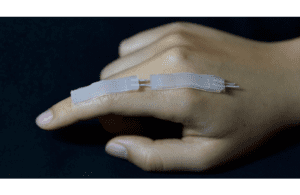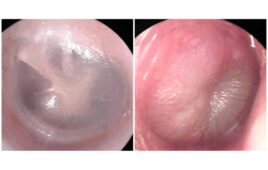
[Image from Harvard University]
The sensor features a non-toxic, highly conductive liquid solution that is more conductive than other biocompatible solutions.
“We have developed a new type of conductive liquid that is no more dangerous than a small drop of salt water,” Siyi Xu, first author on the study, said in a press release. “It is four times more conductive than previous biocompatible solutions, leading to cleaner, less noisy data.”
The sensing solution is made using potassium iodide and glycerol. The two compounds are mixed together and the glycerol breaks the crystal structure of the potassium iodide to form potassium cations and iodide ions to make the liquid conductive.
Glycerol has a lower evaporation rate than water and potassium iodide is highly soluble. This means that the liquid is stable across a range of temperatures and humidity levels and is highly conductive.
“Previous biocompatible soft sensors have been make using sodium chloride-glycerol solutions but these solutions have low conductivities, which makes the sensor data very noisy, and it also takes about 10 hours to prepare,” Xu said. “We’ve shortened that down to about 20 minutes and get very clean data.”
The sensor is designed as a silicon-rubber sensor that can sit on top of the finger or on the fingertip, allowing for better sensing in children.
“We often see that children who are born early or who have been diagnosed with early developmental disorders have highly sensitive skin,” Eugene Goldfield, coauthor on the study, said. “By sticking to the top of the finger, this device gives accurate information while getting around the sensitively of the child’s hand.”
Goldfield currently studies motor function and suggests that motion capture can tell a lot about movement, but it cannot measure force, which can be critical to diagnosing neuromotor and cognitive developmental disabilities.
“Early diagnosis is the name of the game when it comes to treating these developmental disabilities and this wearable sensor can give us a lot of advantages not currently available,” Goldfield said.
While the device has only been tested on adult hands, the researchers plan to scale it down to test on the hands of children.
“The ability to quantify complex human motions gives us an unprecedented diagnostic tool,” Rob Wood, senior author on the study, said. “The focus on the development of motor skills in toddlers presents unique challenges for how to integrate many sensors into a small, lightweight and unobtrusive wearable device. These new sensors solve these challenges – and if we can create wearable sensors for such a demanding task, we believe that this will also open up applications in diagnostics, therapeutics, human-computer interfaces and virtual reality.”
The research was published in the journal Advanced Functional Materials and was supported but the National Institutes of Health.




